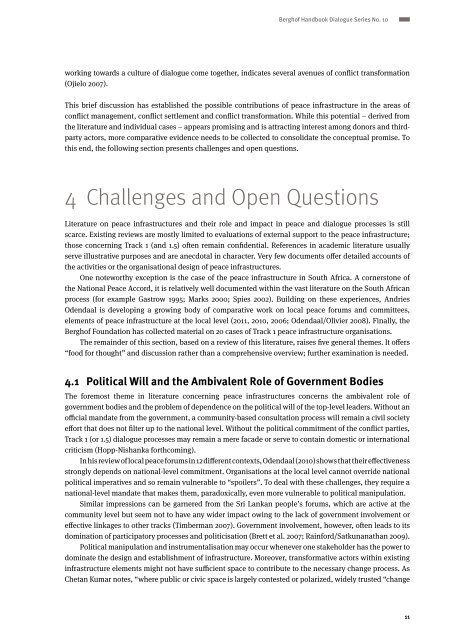Giving Peace an Address? - Berghof Handbook for Conflict ...
Giving Peace an Address? - Berghof Handbook for Conflict ...
Giving Peace an Address? - Berghof Handbook for Conflict ...
Create successful ePaper yourself
Turn your PDF publications into a flip-book with our unique Google optimized e-Paper software.
<strong>Berghof</strong> H<strong>an</strong>dbook Dialogue Series No. 10<br />
working towards a culture of dialogue come together, indicates several avenues of conflict tr<strong>an</strong>s<strong>for</strong>mation<br />
(Ojielo 2007).<br />
This brief discussion has established the possible contributions of peace infrastructure in the areas of<br />
conflict m<strong>an</strong>agement, conflict settlement <strong>an</strong>d conflict tr<strong>an</strong>s<strong>for</strong>mation. While this potential – derived from<br />
the literature <strong>an</strong>d individual cases – appears promising <strong>an</strong>d is attracting interest among donors <strong>an</strong>d thirdparty<br />
actors, more comparative evidence needs to be collected to consolidate the conceptual promise. To<br />
this end, the following section presents challenges <strong>an</strong>d open questions.<br />
4 Challenges <strong>an</strong>d Open Questions<br />
Literature on peace infrastructures <strong>an</strong>d their role <strong>an</strong>d impact in peace <strong>an</strong>d dialogue processes is still<br />
scarce. Existing reviews are mostly limited to evaluations of external support to the peace infrastructure;<br />
those concerning Track 1 (<strong>an</strong>d 1.5) often remain confidential. References in academic literature usually<br />
serve illustrative purposes <strong>an</strong>d are <strong>an</strong>ecdotal in character. Very few documents offer detailed accounts of<br />
the activities or the org<strong>an</strong>isational design of peace infrastructures.<br />
One noteworthy exception is the case of the peace infrastructure in South Africa. A cornerstone of<br />
the National <strong>Peace</strong> Accord, it is relatively well documented within the vast literature on the South Afric<strong>an</strong><br />
process (<strong>for</strong> example Gastrow 1995; Marks 2000; Spies 2002). Building on these experiences, Andries<br />
Odendaal is developing a growing body of comparative work on local peace <strong>for</strong>ums <strong>an</strong>d committees,<br />
elements of peace infrastructure at the local level (2011, 2010, 2006; Odendaal/Olivier 2008). Finally, the<br />
<strong>Berghof</strong> Foundation has collected material on 20 cases of Track 1 peace infrastructure org<strong>an</strong>isations.<br />
The remainder of this section, based on a review of this literature, raises five general themes. It offers<br />
“food <strong>for</strong> thought” <strong>an</strong>d discussion rather th<strong>an</strong> a comprehensive overview; further examination is needed.<br />
4.1 Political Will <strong>an</strong>d the Ambivalent Role of Government Bodies<br />
The <strong>for</strong>emost theme in literature concerning peace infrastructures concerns the ambivalent role of<br />
government bodies <strong>an</strong>d the problem of dependence on the political will of the top-level leaders. Without <strong>an</strong><br />
official m<strong>an</strong>date from the government, a community-based consultation process will remain a civil society<br />
ef<strong>for</strong>t that does not filter up to the national level. Without the political commitment of the conflict parties,<br />
Track 1 (or 1.5) dialogue processes may remain a mere facade or serve to contain domestic or international<br />
criticism (Hopp-Nish<strong>an</strong>ka <strong>for</strong>thcoming).<br />
In his review of local peace <strong>for</strong>ums in 12 different contexts, Odendaal (2010) shows that their effectiveness<br />
strongly depends on national-level commitment. Org<strong>an</strong>isations at the local level c<strong>an</strong>not override national<br />
political imperatives <strong>an</strong>d so remain vulnerable to “spoilers”. To deal with these challenges, they require a<br />
national-level m<strong>an</strong>date that makes them, paradoxically, even more vulnerable to political m<strong>an</strong>ipulation.<br />
Similar impressions c<strong>an</strong> be garnered from the Sri L<strong>an</strong>k<strong>an</strong> people’s <strong>for</strong>ums, which are active at the<br />
community level but seem not to have <strong>an</strong>y wider impact owing to the lack of government involvement or<br />
effective linkages to other tracks (Timberm<strong>an</strong> 2007). Government involvement, however, often leads to its<br />
domination of participatory processes <strong>an</strong>d politicisation (Brett et al. 2007; Rain<strong>for</strong>d/Satkun<strong>an</strong>ath<strong>an</strong> 2009).<br />
Political m<strong>an</strong>ipulation <strong>an</strong>d instrumentalisation may occur whenever one stakeholder has the power to<br />
dominate the design <strong>an</strong>d establishment of infrastructure. Moreover, tr<strong>an</strong>s<strong>for</strong>mative actors within existing<br />
infrastructure elements might not have sufficient space to contribute to the necessary ch<strong>an</strong>ge process. As<br />
Chet<strong>an</strong> Kumar notes, “where public or civic space is largely contested or polarized, widely trusted “ch<strong>an</strong>ge<br />
11
















